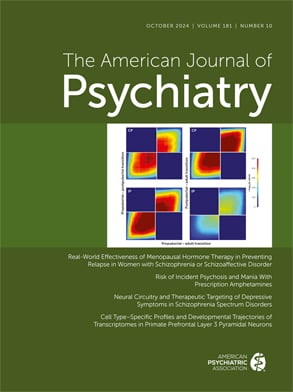To the Editor:
The recently published CATIE study by Jeffrey A. Lieberman, M.D., et al.
(1) had an immediate impact on psychiatrists and the public at large. Although thoughtful and comprehensive, the methodology of the work raises some questions concerning dosage, duration of administration, genetics, and compliance.
The authors themselves identified potential problems with the data resulting from the relatively low dosing of olanzapine, quetiapine, and ziprasidone as well as the absence of aripiprazole as a participant. Corrected data indicated that ziprasidone and olanzapine did not differ significantly with respect to efficacy or discontinuation rates. In the event of treatment failure, clozapine remained available to patients outside the study proper but was not itself included and thus precluded an important yardstick of antipsychotic action.
The late addition of ziprasidone limited its study period to less than those of the other drugs. Even so, these findings as well as earlier work militate for a more thorough evaluation of ziprasidone and the other atypical antipsychotics that merit investigation under similar conditions
(2). The dose range of olanzapine exceeded the manufacturer’s recommendation (2.5–20 mg/day) by a factor of 150%, such that the mean dose, 20.8 mg/day, contrasted sharply with the other atypical medications, whose means remained substantially below their manufacturers’ recommended maxima. Perphenazine use reached its manufacturer’s suggested maximum for hospitalized patients, 32 mg/day, but not the absolute safe limit of 64 mg/day (perphenazine prescribing information from Geneva Pharmaceuticals, Inc., Broomfield, Colo.). Thus, olanzapine realized an advantage the other medications did not enjoy.
The role of genetics in schizophrenia remains largely undefined. Exclusion of patients with tardive dyskinesia from the perphenazine group may have eliminated a group of schizophrenic patients who differed genetically from the remainder. Susceptibility to tardive dyskinesia may find its explanation in polymorphisms in the dopamine D
2 and D
3 receptors
(3).
Drug compliance among schizophrenic patients has for years plagued investigators and clinicians alike. Many other mentally ill patients, including those with bipolar disorder, also have serious compliance problems
(4–
8). Multiple factors affect the compliance of schizophrenic patients, including awareness of the illness, duration of the disease, insidious onset, and poor clinic attendance
(9–
11). Compliance may also vary with available social support, substance abuse, comorbidity, denial, and the quality of the therapeutic alliance
(12–
14). The causes of noncompliance are multivariant and require considerable evaluation.
Although plasma levels have not been established for ziprasidone, they have been broadly determined for the other atypical antipsychotics investigated
(15,
16). Despite poor correlation with clinical response, low plasma levels have been linked to relapse, especially among those who take typical antipsychotics and remain the only indicator aside from positron emission tomography scanning, which aids in the verification of medication use
(17–
21). Unfortunately, the absence of plasma levels in the CATIE study means that no proof of compliance ever occurred
(22).
Perphenazine use in schizophrenia has been longstanding but has not engendered wide study
(23). In one comparison, investigators found the superior efficacy and safety of an atypical antipsychotic versus perphenazine
(24). The rate of extrapyramidal symptoms and tardive dyskinesia differed significantly between the two drugs, with perphenazine showing increasing incidence of these side effects with time, whereas the olanzapine group showed the opposite. Why the designers of the CATIE did not choose chlorpromazine, a solidly established, thoroughly investigated benchmark, puzzles one.
The CATIE study may well overturn the impression that atypical antipsychotics outperform older antipsychotics. Still, clinicians ought not to rush to judgment but remain patient enough to await clarification of some ambiguous aspects of the study.

